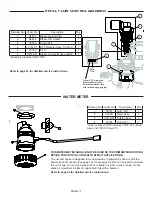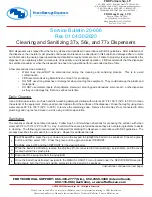
PAGE 3
The control valve, fitting and/or bypass are designed to
accommodate minor plumbing misalignments but are
not designed to support the weight of a system or the
plumbing.
Do not use Vaseline, oils, other hydrocarbon lubricants or
spray silicone anywhere. A silicone lubricant may be used
on black o-rings but is not necessary.
Avoid any type of
lubricants, including silicone, on the clear lip seals.
The nuts and caps are designed to be unscrewed or
tightened by hand or with the special plastic wrench
(V3193). If necessary, pliers can be used to unscrew the
nut or cap. Do not use a pipe wrench to tighten or loosen
nuts or caps. Do not place a screw driver in the slots on
caps and/or tap with a hammer.
Do not use pipe dope or other sealants on threads. Use
Teflon tape on the threaded inlet, outlet and drain fittings.
Teflon tape is not necessary on the nut connection or caps
because of o-rings seals.
After completing any valve maintenance involving the
drive assembly or the drive cap assembly and pistons,
unplug power source jack from the printed circuit board
(black wire) and plug back in or press and hold
NEXT
and
REGEN
buttons for 3 seconds. This resets the electronics
and establishes the service piston position. The display
should flash the software version and then reset the valve
to the service position.
Solder joints near the drain must be done prior to
connecting the drain line flow control fitting. Leave at least
6” between the drain line control fitting and solder joints
when soldering pipes that are connected on the drain
line control fitting. Failure to do this could cause interior
damage to the drain line flow control fitting.
When assembling the installation fitting package (inlet
and outlet), connect the fitting to the plumbing system first
and then attach the nut, split ring and o-ring. Heat from
soldering or solvent cements may damage the nut, split
ring or o-ring. Solder joints should be cool and solvent
cements should be set before installing the nut, split ring
and o-ring. Avoid getting primer and solvent cement on
any part of the o-ring, split rings, bypass valve or control
valve.
Install grounding strap on metal pipes.
This water softener is not to be used for treating
water that is microbiologically unsafe or of unknown
quality without adequate disinfection before or after
treatment.
GENERAL INSTALLATION
AND SERVICE WARNINGS
PRE-INSTALLATION
REVIEW
WATER QUALITY:
If sand or sediment is present in the
water supply, a sediment filter should be installed ahead
of the water softener. Your water softener has been
designed to adequately reduce hardness from levels up
to 100 grains per gallon. Ferrous bicarbonate iron levels
up to 0.5 ppm can also be reduced. This is iron that is
dissolved in water and not visible to the eye in a freshly
drawn sample. After standing in contact with air, the ferrous
iron will become oxidized to the ferric state and start to
precipitate as a reddish brown floc. It can be seen and may
cause discolored water. Air must not come in contact with
water until after it has passed through the water softener.
In some cases, additional treatment equipment may be
needed to treat water having special characteristics, such
as: ferric hydroxide iron, iron bacteria, low pH, tastes and
odors, etc. Consult your dealer if you have any questions.
This water softener is not to be used for treating
water that is microbiologically unsafe or of unknown
quality without adequate disinfection before or after
treatment.
WATER PRESSURE:
A minimum of 20 pounds of water
pressure (psi) is required for regeneration. Maximum
100 psi. CAUTION: the softener cannot be subject to a
vacuum due to loss of pressure (such as a water main
break or submersible well pump check valve failure).
WATER TEMPERATURE:
The range of water temperature
is 35°F to 100°F. DO NOT install any water softener with
less than 10 feet of piping between its outlet and the inlet
of a water heater.
AMBIENT TEMPERATURE:
DO NOT locate softener
where it or its connections (including the drain and
overflow lines) will ever be subject to room temperatures
under 33°F.
ELECTRICITY:
An uninterrupted 120 volt 60Hz source is
required.
Make sure electrical source is not on a timer
or switch.
All electrical connections must be connected
according to local codes. The plug-in transformer is for
dry locations only. Surge protection is recommended with
all electrical connections.
DRAIN:
All plumbing should be done in accordance with
local plumbing codes. The distance between the drain
and the water softener should be as short as possible.
The pipe size for the drain line should be a minimum of
1/2” (inside diameter of pipe).
SOFTENING:
It is recommended that the softener be
installed to soften both the hot and cold water supply. A
separate hard water faucet may be plumbed for drinking
purposes if desired. Outside faucets should be left on
hard water.
BYPASS:
A bypass valve (optional accessory) should
be installed so that water will be available if it should be
necessary to shut off the pressure in order to service the
softener.
Summary of Contents for 7-LX-100
Page 29: ...PAGE 29 NOTES ...




































